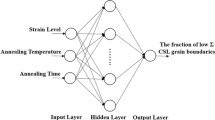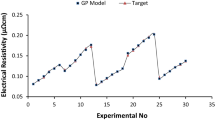Abstract
It is difficult to automatically solve a problem in a systematic method without using computers. In this study, a comparison between Neural Network (NN) and genetic programming (GEP) soft computing techniques as alternative tools for the formulation of electrical resistivity of zinc–iron (Zn–Fe) alloys for various compositions is proposed. Different formulations are supplied to control the verity and robustness of NN and GEP for the formulation to design composition and electrolyte conditions in certain ranges. The input parameters of the NN and GEP models are weight percentages of zinc and iron in the film and in the electrolyte, measurement temperature, and corrosion voltage of the films. The NN- and GEP-based formulation results are compared with experimental results and found to be quite reliable with a very high correlation (R 2=0.998 for GEP and 0.999 for NN).















Similar content being viewed by others
References
A.H. Alavi, A.H. Gandomi, A robust data mining approach for formulation of geotechnical engineering systems. Eng. Comput. 28(3), 242–274 (2011)
A.H. Alavi, A.H. Gandomi, Prediction of principal ground-motion parameters using a hybrid method coupling artificial neural networks and simulated annealing. Comput. Struct. 89(23–24), 2176–2194 (2011)
A.F. Asbour, L.F. Alvarez, V.V. Toropov, Emprical modeling of shear strength of RC deep beams by genetic programming. Comput. Struct. 81(5), 331 (2003)
A. Brenner, Electrodeposition of Alloys—Principles and Practice (Academic Press, New York, 1963)
E. Budman, R. Sizelove, www.metalfinishing.com
A. Cevik, A new formulation for web crippling strength of cold-formed steel sheetingb using genetic programming. J. Constr. Steel Res. 63, 1305 (2007)
A. Cevik, A.F. Cabalar, Modelling damping ratio and shear modulus of sand–mica mixtures using genetic programming. Expert Syst. Appl. 36(4), 7749–7757 (2009)
C.T. Cheng, W.C. Wang, D.M. Xu, K.W. Chau, Optimizing hydropower reservoir operation using hybrid genetic algorithm and chaos. Water Resour. Manag. 22(7), 895–909 (2008)
J.V. Davidson, D.A. Savic, G.A. Walters, Symbolic and numerical regression: experiments and application. Inf. Sci. 150(1/2), 95 (2003)
C. Ferreira, Gene expression programming in problem solving. Invited Tutorial of the 6th Online World Conference on Soft Computing in Industrial Applications, September 10–24, 2001
C. Ferreira, Gene expression programming: a new adaptive algorithm for solving problems. Complex Syst. 13(2), 87 (2001)
C. Ferreira, Gene Expression Programming: Mathematical Modeling by an Artificial Intelligence (Angra do Heroismo, Portugal, 2002). ISBN 972-95890-5-4. http://www.gene-expressionprogramming.com/GepBook/Introduction.htm
A.H. Gandomi, A.H. Alavi, M.R. Mirzahosseini, F. Moghadas Nejad, Nonlinear genetic-based models for prediction of flow number of asphalt mixtures. J. Mater. Civ. Eng. 23(3), 248–263 (2011)
W. Geertsma, Clustering of atoms and the metal non-metal transition. J. Phys. C, Solid State Phys. 18, 2461–2481 (1985)
E. Güneyisi, M. Gesoğlu, T. Özturan, E. Özbay, Estimation of chloride permeability of concretes by empirical modeling: considering effects of cement type, curing condition and age. Constr. Build. Mater. 23(1), 469–481 (2009)
C.K. Gupta, Chemical Metallurgy (Wiley-VCH, Weinheim, 2003), p. 7. ISBN:3-527-30376-6
R. Hecht-Nielsen, Neurocomputing (Addison-Wesley, Reading, 1990)
T. Ji, T. Lin, X. Lin, A concrete mix proportion design algorithm based on artificial neural networks. Cem. Concr. Res. 36, 1399–1408 (2006)
W. Jia, B. Ling, K.W. Chau, L. Heutte, Palmprint identification using restricted fusion. Appl. Math. Comput. 205(2), 927–934 (2008)
A. Jimenéz, H. Schmidt, Trat. Superf. 120, 26 (2003)
E. Kanca, M. Eskil, Comparison of new formulations for martensite start temperature of Fe–Mn–Si shape memory alloys using geneting programming and neural networks. Comput. Mater. Continua 10(1), 65–95 (2009)
İ.H. Karahan, Ö.F. Bakkaloğlu, Empirical modeling of magnetoresistance and electrical resistivity properties of electrodeposited CuCoNi alloys. J. Optoelectron. Adv. Mater. 11(3), 311–319 (2009)
İ.H. Karahan, H.S. Güder, Electrodeposition and properties of Zn, Zn–Ni, Zn–Fe and Zn–Fe–Ni alloys from acidic chloride–sulphate electrolytes. Inst. Met. Finish. 87(3), 155–158 (2009)
İ.H. Karahan, J. Mater. Sci. 42(24), 10160–10163 (2007)
İ.H. Karahan, R. Özdemir, A new modeling of electrical resistivity properties of ZnFe alloys using genetic programming. J. Optoelectron. Adv. Mater. 4(6), 812–815 (2010)
J.R. Koza, Genetic Programming: On the Programming of Computers by Means of Natural Selection (MIT Press, Cambridge, 1992)
D.C. Leitao, C.T. Sousa, J. Ventura, J.S. Amaral, F. Carpinteiro, K.R. Pirota, M. Vazquez, J.B. Sousa, J.P. Araujo, Characterization of electrodeposited Ni and Ni80Fe20 nanowires. J. Non-Cryst. Solids 354, 5241–5243 (2008)
J.Y. Lin, C.T. Cheng, K.W. Chau, Using support vector machines for long-term discharge prediction. Hydrol. Sci. J. 51(4), 599–612 (2006)
A.R. Lopez, G.M.L. Fdez, A. Garcia-Arribas, J. Herreros, M. Insausti, Preparation and characterisation of Cu–Co heterogeneous alloys by potentiostatic electrodeposition. Mater. Sci. Eng. A 335, 94–100 (2002)
A. Mollahasani, A.H. Alavi, A.H. Gandomi, Empirical modeling of plate load test moduli of soil via gene expression programming. Comput. Geotech. 38(2), 281–286 (2011)
N. Muttil, K.W. Chau, Machine learning paradigms for selecting ecologically significant input variables. Eng. Appl. Artif. Intell. 20(6), 735–744 (2007)
C.S. Ong, J.J. Huang, G.H. Tzeng, Building credit scoring models using genetic programming. Expert Syst. Appl. 29(1), 41 (2005)
R. Ramanauskas, Structural factor in Zn alloy electrodeposit corrosion. Appl. Surf. Sci. 153, 53–64 (1999)
D.E. Rumelhart, G.E. Hinton, R.J. Williams, Learning internal representation by error propagation, in Parallel Distributed Processing: Exploration in the Microstructure of Cognition, vol. 1, ed. by D.E. Rumelhart, J.L. McClleland (MIT Press, Cambridge, 1986)
N.R. Short, S. Zhou, J.K. Dennis, Electrochemical studies on the corrosion of a range of zinc alloy coated steel in alkaline solutions. Surf. Coat. Technol. 79(1–3), 218–224 (1996)
R.E. Smallman, R.J. Bishop, Modern Physical Metallurgy and Materials Engineering, 6th edn. (Reed Educational and Professional Publishing Ltd., Oxford, 1999)
S. Strehle, J.W. Bartha, Wetzig electrical properties of electroplated Cu(Ag) thin films. Thin Solid Films 517, 3320–3325 (2009)
A. Thakur, P.K. Ahluwalia, Electrical resistivity of NaSn compound forming liquid alloy using ab initio pseudopotentials. Physica B, Condens. Matter 373(1), 163–168 (2006)
T. Tsuru, S. Kobayashi, T. Akiyama, H. Fukushima, S.K. Gogia, R. Kammel, Electrodeposition behaviour of zinc–iron group metal alloys from a methanol bath. J. Appl. Electrochem. 27, 209–214 (1997)
J.X. Xie, C.T. Cheng, K.W. Chau, Y.Z. Pei, A hybrid adaptive time-delay neural network model for multi-step-ahead prediction of sunspot activity. Int. J. Environ. Pollut. 28(3–4), 364–381 (2006)
X.S. Yang, A.H. Gandomi, S. Talatahari, A.H. Alavi, Metaheuristics in Water Resources, Geotechnical and Transportation Engineering (Elsevier, Waltham, 2012). ISBN:9780123982964
J. Zhang, K.W. Chau, Multilayer ensemble pruning via novel multi-sub-swarm particle swarm optimization. J. Univers. Comput. Sci. 15(4), 840–858 (2009)
Author information
Authors and Affiliations
Corresponding author
Rights and permissions
About this article
Cite this article
Karahan, İ.H., Ozdemir, R. & Erkayman, B. A comparison of genetic programming and neural networks; new formulations for electrical resistivity of Zn–Fe alloys. Appl. Phys. A 113, 459–476 (2013). https://doi.org/10.1007/s00339-013-7544-3
Received:
Accepted:
Published:
Issue Date:
DOI: https://doi.org/10.1007/s00339-013-7544-3




